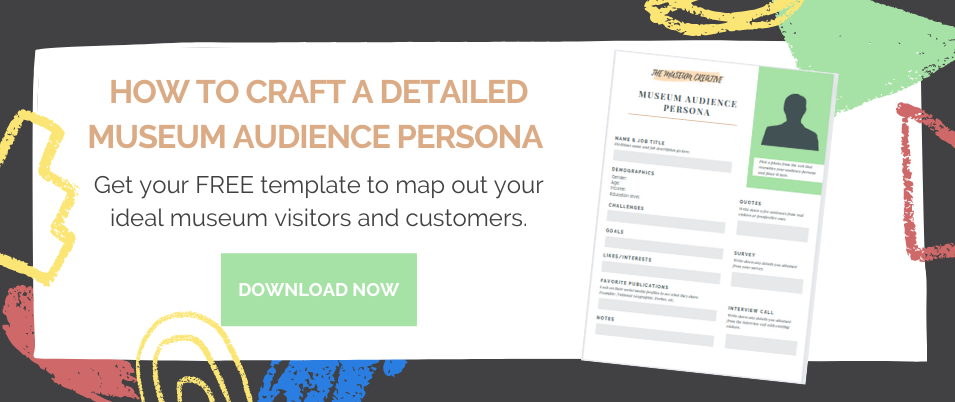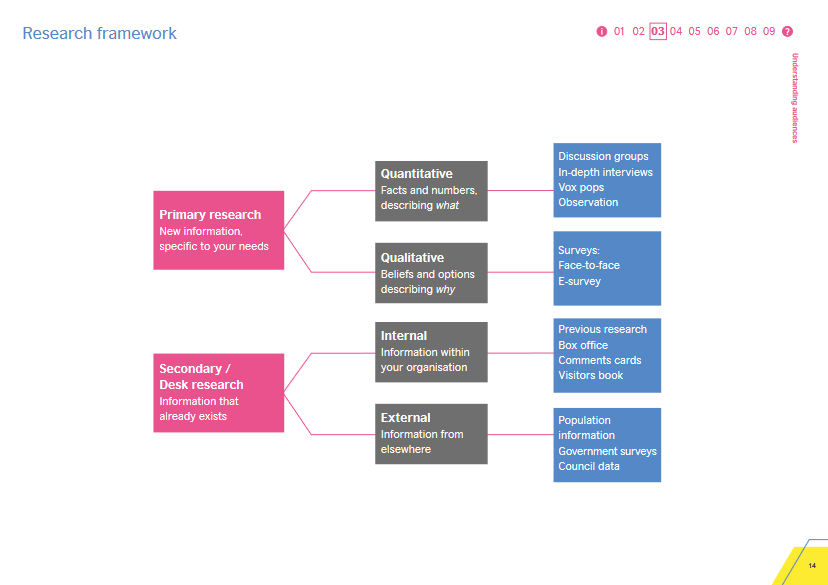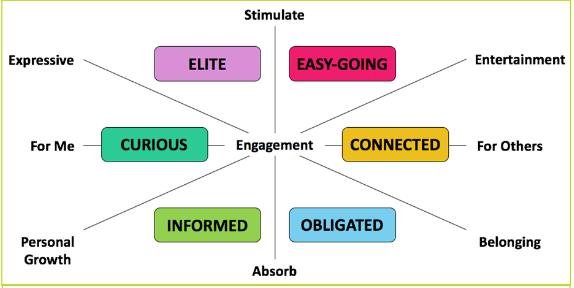Museum Audience Research: 7 Key Steps to Defining Your Ideal Visitors and Customers
It’s sad but true.
Museum visitor numbers have been hit hard by the Covid Pandemic.
In 2021, the attendance rate was just a quarter of what it had been in 2019-20, and the income loss was up to 44% of annual revenues.
Luckily, the sector's financial crisis has subsided ever since: footfall has started to rebound, with average profits rising to 68%.
That’s a positive sign!
However, the slow recovery is leading museums to find new strategies to rebuild their audiences, grow visibility, and bring in more visitors - first and foremost, through the creation of customer-centric content.
Here’s where things get tricky…
If you don’t have a deep understanding of your target audience and their needs, you can’t create content that speaks to them.
Who’s visiting your museum? What topics interest people? How do they benefit from your collections?
These and other questions are the starting point of a thorough museum audience research that lets you:
Get to know your existing audience.
Find new potential visitors.
Increase engagement.
Stay relevant to your following through content that resonates.
In today’s post, you’ll dive into seven key steps to doing insightful visitor research and creating an audience persona that helps museum attendance growth and income generation success. 💯
Let’s do this!
What Is Museum Audience Research and Why Is It Important?
The main goal in creating valuable online content is to impact your audience, increase the number of museum visitors, and drive more sales.
Content must gravitate towards your readers’ needs - that’s why audience research is critical!
If you don’t know who you’re targeting, people won’t engage with you, nor will they buy the services/products you offer.
But…
An in-depth analysis of your audience’s behavior, pain points, and desires will help you:
Identify your ideal visitors/customers.
Elaborate relevant content that positions you as an authority.
Form authentic relationships.
Generate loyalty and trust.
Attract the right leads.
Stand out from the competition.
Keep your marketing activities consistent and effective.
From your museum audience research, you’ll pull out a clearly defined persona to write content for and base your entire strategy on.
See it as a detailed description of your target visitors.
If you learn what they need and solve their problems, your personas will connect with you and become real customers. (How to attract people to visit your museum or communicate with them will be a no-brainer!)
7 Steps to Doing Museum Audience Research and Building Your Audience Persona
It’s time to get down to the nitty-gritty of museum audience research!
A consistent study of your persona involves:
Finding out what makes your online community tick.
Addressing your audience priorities.
Targeting specific types of people that may turn into prospects.
Tailoring your content to every persona outlining your audience segments.
Bear in mind the real-world data and common trends you collect will be the foundation of your content marketing plan - so make sure to invest time and effort in the process to get the best results.
But how do you do audience research?
The following paragraphs will guide you through seven easy steps to researching and building a target persona that works.
You’ll learn the correct strategy for successful marketing activity and explore methods that will set you apart from the 85% of marketers who don’t efficiently use buyer personas.
Let’s jump right in!
Research Your Audience
Good personas require solid and accurate research.
Who is your museum target audience? What age group visits your museum the most? How do other museums attract visitors?
You need to dig deep to find this type of information and gather useful data that will help in creating your audience persona.
Example of a research framework. (British Council)
Here’s how to get the most out of your museum audience research:
Use social listening tools like Sprout Social and BuzzSumo to monitor mentions and conversations about your museum.
Analyze museum audience demographics and stats by searching data on your online community and existing visitors from your customer database, social media analytics (like Facebook Audience Insights), and Google Analytics.
Find out which social media channels your audience is most active on, using tools like Keyhole.co or Hootsuite Insights.
Study your competition with the help of competitor analysis tools like Talkwalker Quick Search and Brand24.
Not only will you get a better understanding of your targets, but you’ll also single out what’s relevant to your niche and industry.
2. Make Surveys/Interview Calls
Surveys and interview calls are another great way to define the types of museum audiences you aim to address.
You’ll get demographic information from real people, listen to their pain points, and learn how your museum can meet their expectations.
Reach out to your current visitors, previous customers, patrons, sales team members, and whoever is already involved in your institution to get valuable insights into your audience’s preferences, interests, and behaviors.
Here’s how:
Create a Google Forms or SurveyMonkey cheatsheet targeted to your persona and share it with the public on your website, social media platforms, or via emails. (Using incentives like a special membership discount or a gift card can really motivate people to participate in your museum audience survey.)
Example of a museum visitor response survey. (Wood County Historical Center, Ohio)
When planning an interview call, prepare a script with the key questions to ask your interviewees - keep it short and simple by focusing on essential information like who they are, what they do, what impressions they have about your museum, and what they expect from you.
Once you’ve collected enough data, sort through the answers you got to pinpoint common trends and attributes that will be part of your persona profile and ideal visitor.
3. Create Target Segments
The next step in your museum audience research is to group visitors into segments.
You’ll…
Categorize your visitors based on common traits related to their behavior, motivations, and values.
Identify and address unique people’s needs.
Refine your marketing message and engagement strategies.
Museum audience segmentation goes beyond simple demographic analysis, investigating why visitors attend museums, what experiences they seek, and what activities/events they prefer.
Example of visitor segmentation. (Museums Victoria, Melbourne)
With the support of specific tools like Culture Segments or Audience Spectrum, you’ll learn ways to strategically target your museum audience segments, develop deeper relationships with them, and maximize loyalty.
Here’s an example:
“Using Culture Segments allowed us to really get to grips with what our audience was likely to look like based on who was really interested in what we were offering.”
4. Identify Audience’s Pain Points and Goals
An essential part of building your persona is to highlight your target audience’s pain points and objectives.
What’s holding them back from visiting your museum? What do they expect to see and learn? What barriers do they face in the museum environment?
Finding the answers to these and other questions will allow you to:
Make your institution more accessible, welcoming, and inclusive.
Create engaging programs and customized experiences.
Offer better services/products.
Improve your online engagement and exposure.
Optimize your overall content strategy.
Speak with your staff from the customer support department to the marketing teams, analyze social media performance, and do online research on what people are saying about you to highlight gaps and opportunity areas.
Think about it…
If you know how to communicate with your audiences, fulfill their desires/needs, and nurture them through compelling content, they’ll be eager to come to you. From this to converting into loyal customers, the step is short.
5. Define How You Can Help Your Audience
At this point, you have a good grasp on your audience’s wants and struggles.
The next move is to think about how your offer can be of help, meaning to focus on the benefits of your museum’s programs, exhibits, and events involving your community.
Try to answer the following…
In what way do your services improve people’s lives? What downsides does your museum have? How can you attract new visitors and make the existing ones come back? Or how can you increase membership subscriptions?
Ask yourself these questions for every challenge and goal discovered during your museum audience research to deliver an offer that caters to your prospective visitors.
Also, evaluate the lifecycle stage of the buying journey they’re at to easily create customer-centric content that gets you to your ROI quickly.
How content marketing spans all stages of a buyer’s journey. (Search Engine Watch)
6. Build Your Audience Persona
It’s time to craft your audience persona!
Gather all your research and start looking for commonalities. As you place these characteristics in groups, you define your unique personas.
Make them as realistic as possible by including:
Name
Age
Photo
Demographics
Career, position, and salary
Challenges/pain points
Goals
Likes/interests
Favorite brands/publications
Social media channels they use
Example of a museum audience persona. (Museum Planning)
Remember: you aim to create a detailed description of one ideal visitor/customer, highlighting what they currently are and who they hope to be - this will give you a leg up on ideating effective ways to fulfill their goals with your services.
A few more recommendations on your persona:
Make it the touchstone of your content creation and overall marketing strategy.
Share it with your team to produce targeted content that resonates with your leads.
Update it periodically to reflect your business priorities and changing audience.
Create multiple personas if you have multiple niche audiences to target.
I won’t lie: putting together an effective persona requires time and a great deal of effort, but that’s not hard to craft!
It’s all in your museum audience research and customer data - the rest will come naturally along with a better sense of who you serve.
7. Map Your Persona To Marketing Lifecycle Stages
Now that you’ve built your audience personas, you need to know where they are in the marketing lifecycle: Do they know your museum yet? Have they bought from you before? Are they unsure whether your offer is helpful to them?
The marketing lifecycle. (Express Writers)
Identifying a persona’s lifecycle stage lets you elaborate content that is functional to their specific needs/goals, making them move through the four stages of the cycle.
Here’s where it gets even more exciting...
Your audience will start seeing you as THE SOLUTION to their problems.
Plus, the authentic connections developed through impactful, personalized online content will convert them into devoted visitors and buyers.
Your ultimate goal is to boost brand awareness, sales, and conversions; so use audience personas strategically to leverage your content creation success.
Museum Audience Research Is Key to Skyrocketing the Attendance Rate and Sales
Congrats! 🥳
Now you have the strategy - and tools - to conduct a results-driven museum audience research and craft personas based on your target audience’s demographics, pain points, and goals.
In-depth knowledge of what your ideal visitors need is key to customized content that meets their demands. You’ll bond with them, gain their trust, and make it easier to close sales.
If necessary, segment your audience into multiple personas to facilitate the research, and tailor your messaging to each category having in mind the stage of the marketing lifecycle your persona is at.
As you put the process into action, you’ll see the benefits of shaping content marketing around your audience persona.
Consistent use of it will ultimately ensure growth in your conversion rates. 🚀
Not sure how to build an audience persona that works? Download the FREE plug-n-play audience persona template to easily craft your ideal museum visitors and customers!












